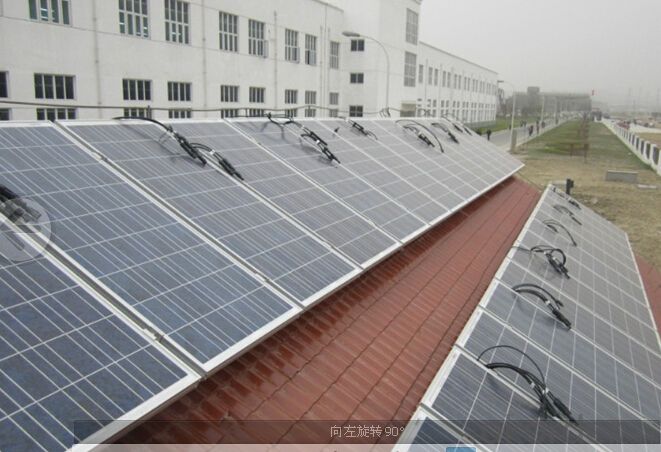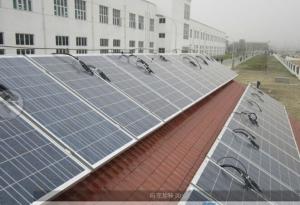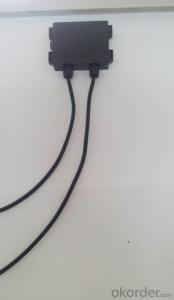Factor Directly Sale 285W Poly Silicon Solar Module CNBM
- Loading Port:
- Qingdao
- Payment Terms:
- TT OR LC
- Min Order Qty:
- 10 set
- Supply Capability:
- 300000 set/month
OKorder Service Pledge
OKorder Financial Service
You Might Also Like
Quick Details
| Place of Origin: | China (Mainland) | Brand Name: | CNBM | Model Number: | 285W solar module |
| Material: | Polycrystalline Silicon | Size: | 1956*992*50mm | Number of Cells: | 72 |
| Max. Power: | 285W | Cell Size(mm): | 156*156 | Tolerance: | 0~3% |
| Cells Number(pcs): | 6*12 | Weight(Kg): | 25 | Max.Series Fuse Rating (A): | 15 |
| Max.System Voltage-IEC(V): | 1000 |



Polycrystalline Solar Module
XH250P(72)/ XH275P(72)/ XH300P(72)
Models | XH250P(72) | XH285P(72) | XH300P(72) |
Max. Power (Pmax) | 250Wp | 285Wp | 300Wp |
Optimum Operating Voltage (Vm) | 34.8V | 35.7V | 35.9V |
Optimum Operating Current (Im) | 7.18A | 7.77 A | 8.08A |
Open-circuit Voltage (Voc) | 43.8V | 35.4 V | 44.4V |
Short-circuit Current (Isc) | 8.04A | 8.24 A | 8.62A |
Cells efficiency | 14.6% | 15.8% | 16.8% |
Dimension L×W×H (mm) | 1956×992×50mm | 1956×992×50 | 1956×992×50 |
Power Tolerance (Pmax) | 0 ~ +3% | 0 ~ +3% | 0 ~ +3% |
Numbers of cells | 60pcs poly solar cell 156×156mm | 72pcs poly solar cell 156×156mm | 72pcs poly solar cell 156×156mm |
weight | 25kg | 25kg | 25kg |
Max system voltage | 1000V DC | 1000V DC | 1000V DC |
Temperature cycling range | -40℃ ~ +85℃ | -40℃ ~ +85℃ | -40℃ ~ +85℃ |
- Q:Can solar cells be used in countries with limited sunlight?
- Yes, solar cells can still be used in countries with limited sunlight. While solar cells generate the most electricity under direct sunlight, they can still generate power even in cloudy or overcast conditions. Additionally, advancements in solar panel technology have made them more efficient in capturing diffuse sunlight, enabling their use in regions with limited sunlight.
- Q:Can solar cells be used to power remote agricultural monitoring systems?
- Yes, solar cells can be used to power remote agricultural monitoring systems. Solar cells convert sunlight into electricity, providing a sustainable and reliable source of power in remote areas. This allows agricultural monitoring systems to operate efficiently and continuously, enabling farmers to remotely monitor and manage their crops, weather conditions, soil moisture, and other important data for optimizing agricultural practices.
- Q:Can solar cells be used in underwater vehicles?
- Yes, solar cells can be used in underwater vehicles. However, due to the limited availability of sunlight underwater, the efficiency of solar cells is significantly reduced compared to their performance on the surface. Therefore, other power sources such as batteries or fuel cells are often used in conjunction with solar cells to provide continuous power to underwater vehicles.
- Q:How about the current market price for the film solar?
- Just for your reference, we are a film solar supplier based in US, and the price for the film solar is around USD 20 each.
- Q:What kind of products can be considered as the solar cell products?
- Here are some of the solar cell products I can recall for now:Solar notebook, Solar-powered calculator, Solar-powered desalination unit, Solar-powered radio, Solar-powered refrigerator.
- Q:How much energy can a solar cell produce?
- The amount of energy a solar cell can produce depends on various factors such as its size, efficiency, sunlight intensity, and duration of exposure. On average, a standard solar cell can generate around 200 to 300 watts of power per square meter under optimal conditions. However, advancements in technology are continuously increasing the efficiency and power output of solar cells.
- Q:What is the impact of bird nesting on solar cell performance?
- Bird nesting can have a negative impact on solar cell performance as it can lead to shading, blocking sunlight from reaching the cells and reducing their efficiency. Additionally, bird droppings can accumulate on the surface of the solar panels, further decreasing their output. Regular maintenance and cleaning are essential to minimize the impact of bird nesting on solar cell performance.
- Q:How do solar cells handle shading or obstructions?
- Solar cells are designed to handle shading or obstructions by using bypass diodes. These diodes allow the current to bypass the shaded or obstructed area, ensuring that the remaining unshaded cells can still generate electricity. This helps minimize the impact of shading or obstructions on the overall performance of the solar panel.
- Q:How do solar cells perform in areas with high levels of air pollution and dust?
- Solar cells perform less efficiently in areas with high levels of air pollution and dust. The particles in the air and dust settle on the surface of the solar cells, reducing their ability to absorb sunlight and convert it into electricity. This buildup of dirt can significantly decrease the overall performance and output of the solar panels. Regular cleaning and maintenance are crucial in such areas to ensure optimal functioning of the solar cells.
- Q:How do solar cells perform in areas with high humidity?
- Solar cells generally perform slightly less efficiently in areas with high humidity. The moisture in the air can create a barrier between the sunlight and the solar cells, reducing their ability to convert sunlight into electricity. However, advancements in solar cell technology have improved their performance in high humidity conditions, making them still viable and effective in such areas.
1. Manufacturer Overview |
|
|---|---|
| Location | |
| Year Established | |
| Annual Output Value | |
| Main Markets | |
| Company Certifications | |
2. Manufacturer Certificates |
|
|---|---|
| a) Certification Name | |
| Range | |
| Reference | |
| Validity Period | |
3. Manufacturer Capability |
|
|---|---|
| a)Trade Capacity | |
| Nearest Port | |
| Export Percentage | |
| No.of Employees in Trade Department | |
| Language Spoken: | |
| b)Factory Information | |
| Factory Size: | |
| No. of Production Lines | |
| Contract Manufacturing | |
| Product Price Range | |
Send your message to us
Factor Directly Sale 285W Poly Silicon Solar Module CNBM
- Loading Port:
- Qingdao
- Payment Terms:
- TT OR LC
- Min Order Qty:
- 10 set
- Supply Capability:
- 300000 set/month
OKorder Service Pledge
OKorder Financial Service
Similar products
New products
Hot products
Hot Searches
Related keywords



























